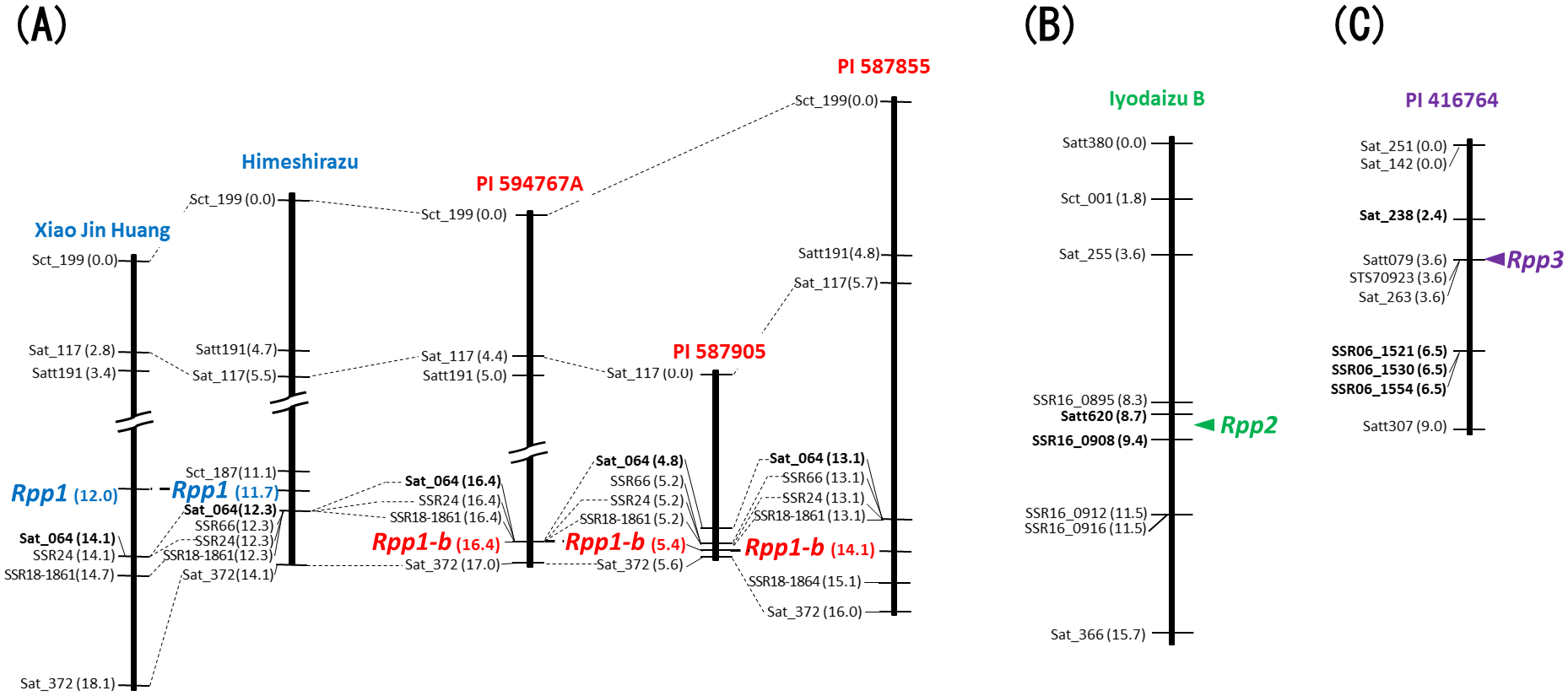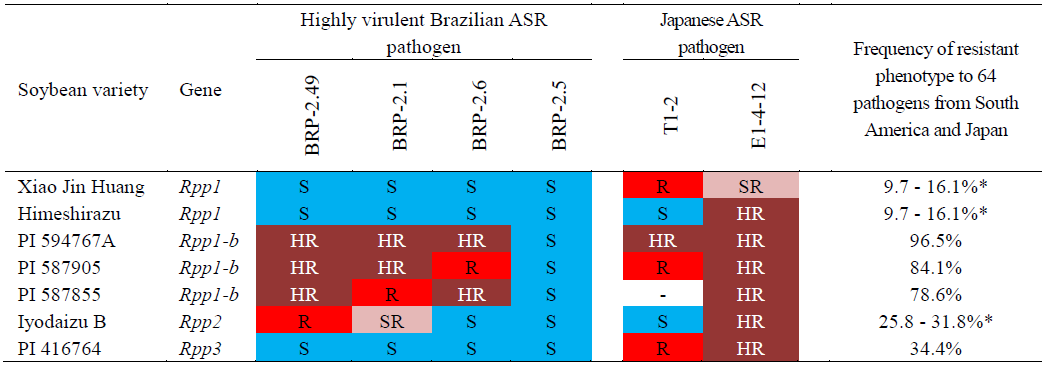Three differential soybean varieties highly resistant to Asian soybean rust carry the resistance gene Rpp1-b
Description
Asian soybean rust (ASR), a soybean disease caused by Phakopsora pachyrhizi, is one of the biggest threats to soybean production in South America where more than half of soybean in the world market is produced. Although an environment-friendly, cost-effective, and long-term management of ASR can be achieved through use of ASR-resistant soybean cultivars, only a limited number of resistance resources are available for soybean breeding in South America because of the high virulence and diversity of ASR pathogens. For this reason, we are examining ASR-resistant soybeans whose resistance genes have not been identified yet and are therefore unused in breeding programs. We previously studied the Chinese soybean varieties PI 594767A (Zhao Ping Hei Dou), PI 587905 (Xiao Huang Dou), PI 587855 (Jia Bai Jia), and Xiao Jin Huang, and the Japanese soybean varieties Himeshirazu, Iyodaizu B, and PI 416764 (Akasaya). We identified their resistance to ASR pathogens from South America and Japan, with PI 594767A, PI 587905, PI 587855, and PI 416764 among those included in the international set of soybean differentials used in identifying the pathogenicity of ASR pathogens. The aim of this study, therefore, was to identify the ASR-resistance loci in these seven soybean varieties and tag the resistance genes to DNA markers. This information will be useful in marker-assisted breeding programs for ASR resistance.
F2 populations were developed by crossing a susceptible variety, BRS184, with each of the seven resistant varieties. Each population was inoculated with an appropriate ASR pathogen and the phenotypes were determined as either resistant (R) or susceptible (S). Then, the loci for ASR resistance were mapped together with the DNA markers. In case the boundary between R and S was unclear in the F2 population, the resistance locus was mapped as a quantitative trait locus (QTL) for sporulation level (SL).
Figure 1 shows that Xiao Jin Huang and Himeshirazu carry Rpp1, whereas PI 594767A, PI 587905, and PI 587855 carry Rpp1-b. Rpp1 and Rpp1-b, both known as ASR-resistance genes, are located close to each other on chromosome 18. Furthermore, the QTL for SL was mapped on the chromosome region of Rpp2 and Rpp3 for Iyodaizu B and PI 416764, respectively. Since the ASR resistance loci of these seven soybean varieties were successfully identified together with the DNA markers linked to their resistance loci, these resistant varieties can be used in marker-assisted breeding programs for ASR resistance. Among the seven varieties, PI 594767A, PI 587905, and PI 587855 have been found to carry Rpp1-b. They are especially useful for soybean breeding because they are resistant not only to 78.6%-96.5% of ASR pathogens from South America and Japan but also to three highly virulent Brazilian ASR races (Table 1).
Figure, table
-
Fig. 1. Molecular linkage maps of ASR resistance loci in seven soybean varieties. It shows (A) soybean chromosome 18 where Rpp1 and Rpp1-b are located; (B) chromosome 16 where Rpp2 is located; and (C) chromosome 6 where Rpp3 is located. The loci Rpp2 and Rpp3 were determined by quantitative trait locus (QTL) analysis for sporulation level (SL) in ASR disease. The names of DNA markers and genetic distance (cM) from the top of linkage groups are shown on the left side of each linkage group.
-
Table 1. Reactions of seven ASR-resistance soybean varieties to ASR pathogens from South America and Japan HR: Highly resistant; R: Resistant; SR: Slightly resistant; S: Susceptible; -: No data.
*The ranges of frequencies shown here are based on different varieties but carrying either Rpp1 or Rpp2.
- Affiliation
-
Japan International Research Center for Agricultural Sciences Biological Resources and Post-harvest Division
- Research project
- Program name
- Term of research
-
FY2016(FY2011〜FY2020)
- Responsible researcher
-
Yamanaka Naoki ( Biological Resources and Post-harvest Division )
MIERUKA ID: 001770Hossain Md. Motaher ( Bangabandhu Sheikh Mujibur Rahman Agricultural University, BSMRAU, Bangladesh )
- ほか
- Japanese PDF
-
A4 318.47 KB
A3 226.16 KB
- English PDF
-
A4 686.9 KB
A3 621.45 KB
- Poster PDF
-
Poster 416.77 KB


